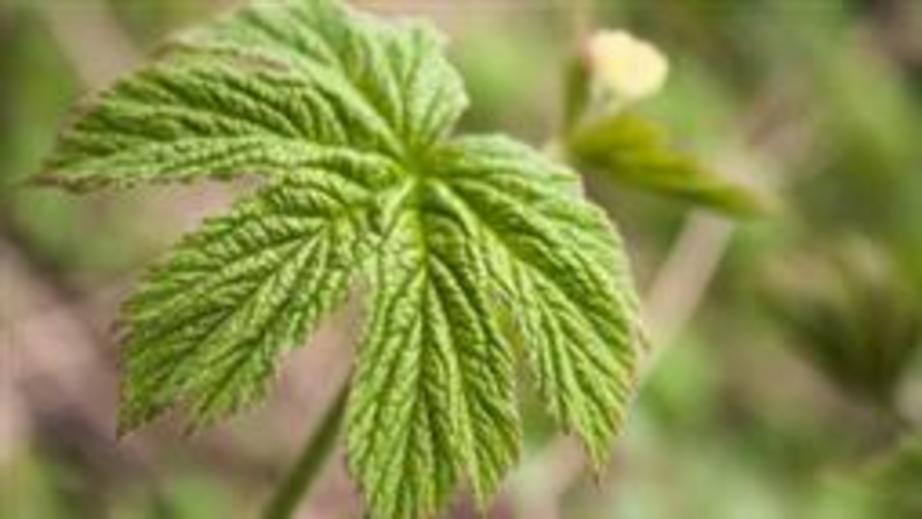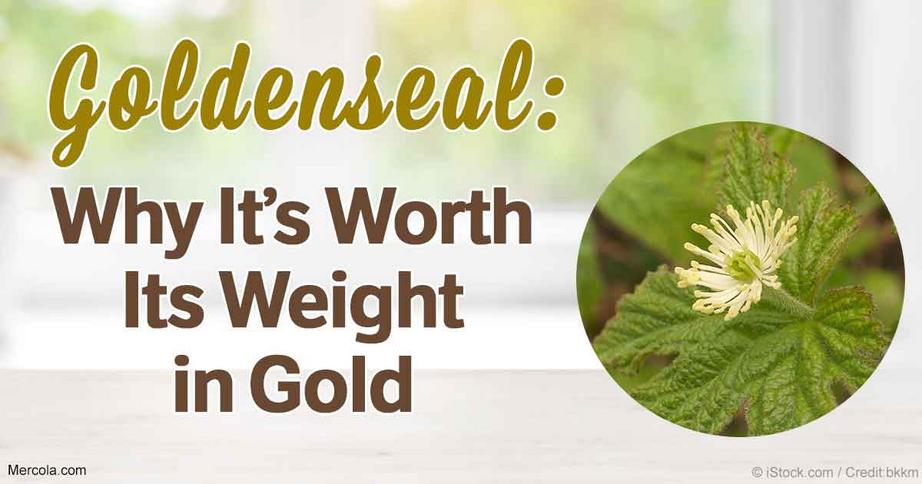Goldenseal: an herb that could be worth its weight in gold
Story at-a-glance
- Native Americans have been using goldenseal for a long time, and have revered it for its wide array of health benefits
- Believed to help treat several different health conditions, from upset stomach to cancer, goldenseal is valued in the U.S. for its healing qualities

Native Americans have been using goldenseal for a long time, and have revered it for its wide array of health benefits. This valuable herb is believed to work against numerous ailments, from upset stomach to jaundice, and may even have cancer-protective properties. But because it’s so sought after, the population of this wild-growing plant is now dwindling. Discover important facts about goldenseal and find out why this age-old herb is considered one of the most versatile traditional cures of all time.
What Is Goldenseal?
A low-sprawling woodland plant that belongs to the Ranunculaceae, or buttercup, family, goldenseal (Hydrastis canadensis) is native to eastern North America, from Ontario, Canada, to south Georgia in the U.S.; and from Oklahoma to South Carolina.
It once grew thick in the Ohio River valley, but today is considered endangered, critically imperiled, rare, uncommon or threatened in Canada and 27 U.S. states, including Tennessee, where it is considered commercially exploited due to over-collection for the herbal industry.1,2,3
The plant grows up to 1 foot tall, and can be identified through its 1-foot-wide palm-shaped leaves, an erect and hairy stem and small, greenish-white flowers that bloom in spring and turn into a cluster of red, inedible berries. The flowers bloom into stamens (arm-like spokes), and do not have petals.
As a threatened species, goldenseal was added to Appendix 11 of the Convention on International Trade in Endangered Species list in 1997, which means that it now must be artificially propagated for commercial use, with its roots, rhizomes, rootstocks and bulk powder highly regulated for trade.4
Goldenseal plant is also known as eye root, hydraste, eyebalm, Indian turmeric, orange root and yellow root, to name a few. Its most well-known moniker, however, is based on its thick yellow rhizome, or the root. Goldenseal root is said to be the source of this plant’s medicinal powers. This is the part that’s dried and turned into goldenseal powder or capsules, as well as tinctures and creams.5
The roots are also dried to use in teas.6 However, this is also the reason why these plants are disappearing. Unlike other herbs and spices whose leaves and flowers can be safely harvested while keeping the plant intact, goldenseal’s root, once harvested, destroys the plant. And because goldenseal seeds take five to seven years before they can mature, replacing the plant at the same rate it is harvested is difficult.7
Goldenseal Has Been Used for a Long Time
Native Americans greatly valued goldenseal herb, using not only the root, but the leaves and flowers as well. They also used goldenseal root as a potent yellow dye for clothing. Nevertheless, what stands out more are the numerous health benefits of this simple little plant. These native tribes have actually used goldenseal, both medicinally and culturally, for hundreds of years.
For example, the Cherokee mixed goldenseal root with bear fat to use as a topical insect repellent, while the Iroquois drank it to treat fevers and pneumonia. Overall, many Native Americans east of the Mississippi River considered goldenseal a medicinal agent for fighting coughs and tuberculosis, for easing digestive issues and as a potion for eye and skin infections and earaches. Some even used it to treat gonorrhea.8,9,10
Goldenseal’s Health Benefits Are Far-Reaching
But what exactly makes goldenseal so useful for your health? The secret is in the three active alkaloids that it contains, namely hydrastine, palmatine, canadine and berberine.
Berberine, in particular, has anti-inflammatory, antibacterial, antifungal and immune-boosting properties.11,12 It works against various bacteria, fungi and protozoa, and may even help treat gastrointestinal issues. Berberine was even said to have antidiabetic properties13 and may help control blood sugar and lipid metabolism just as efficiently as the diabetes drug metformin.14
Today, although scientific research is still ongoing, 15 goldenseal root is used as a complementary medicine to treat AIDS, while commercial products in supplement form tout it for cold symptoms, hay fever, rhinitis and nasal congestion.16,17 Some people take goldenseal for various respiratory and digestive issues.18 It is also used as an eyewash.19
Aside from the three alkaloids mentioned, goldenseal also offers essential oils, fatty oil and resin. This potent combination can help contribute to the herb’s many health benefits, such as:20,21,22
• Improved gut and gastrointestinal tract (GI) health.23 If you suffer from irregular bowel movements, ulcer, constipation, cramping and bloating, goldenseal may help your system get back on track.It also promotes better digestion and increased bile secretion.
• Relief from sinus conditions. Powdered goldenseal root may help reduce infection and inflammation in the sinus cavities.
• Healing of skin ailments. Thanks to its antimicrobial and antioxidant properties, goldenseal may be effective against acne, eczema, dry skin and psoriasis. It may even help eliminate dandruff.
• Protection for the liver. An animal study published in the journal Pharmacognosy Research has found that goldenseal may have hepatoprotective effects24 that can help protect the liver and prevent liver failure.
• Reduce the risk of cancer. When used with other herbs like red clover, goldenseal may help minimize the risk of certain cancers. One study published in Cancer Chemotherapy and Pharmacology journal25 even demonstrated the effects of berberine for melanoma.
Due to its potent antibiotic effects, some people have found goldenseal effective against urinary tract infections (UTI).26 The berberine in this herb also helps keep infectious bacteria like E. coli27 from attaching to your cell walls.
Goldenseal blends well with some herbs, even helping boost their health-protective properties. One popular herbal combination that’s said to provide immense benefits is goldenseal and Echinacea. When taken in tandem, these two herbs are said to help strengthen your immune system and help keep colds and flu at bay.28
Growing Goldenseal
Goldenseal thrives best in moist forest soils or damp meadows, and often grows wild. However, because this herb is becoming scarce in its natural habitat and is in danger of becoming extinct, then you may want to consider growing your own goldenseal plant. The North Carolina State University provides helpful guidelines in growing goldenseal:29
“Goldenseal can be propagated from rhizome pieces, root cuttings, 1-year-old seedlings or seed. It takes five to seven years to grow harvestable roots from seed and three to five years to grow harvestable roots from rhizome pieces. Root cuttings or seedlings usually take four to six years.
Site selection is the most important factor for producing healthy goldenseal. Goldenseal grows best in a rich, moist, loamy soil with good air and water drainage. Planting on a slight slope will improve drainage. Do not plant in a bottom or in a heavy, poorly drained soil. Goldenseal needs to be grown in the shade, which can be provided artificially or by a natural forest canopy.”
The site also notes that due to the plant’s endangered status in the state, those who wish to cultivate this herb in their backyard need to acquire a permit from the N.C. Department of Agriculture and Consumer Services, Plant Industry Division.
Here’s a Goldenseal Tea Recipe You Can Try
One of the easiest ways to get the benefits of goldenseal is to make an herbal tea from the powdered root or the leaves. Here’s one simple recipe from Organic Facts30 that you can try:
Goldenseal Tea
Ingredients:
• 1 teaspoon goldenseal powdered root or leaves
• 2 to 3 cups boiling water
• Raw honey or lemon, to taste
Procedure:
1. Boil the water in a kettle.
2. Put 1 teaspoon of goldenseal powdered root or leaves in a teacup.
3. Pour the boiling water over the goldenseal and allow to steep for 15-20 minutes.
4. Strain the tea and serve hot. Add lemon or raw organic honey, to taste.
Note: the tea can have a bitter flavor that many may not be able to tolerate, so adding a teaspoon of raw honey may be a good idea.31 You can also add a teaspoon of echinacea to this recipe.
Be Aware of These Potential Goldenseal Side Effects
If taken in small and moderate doses, in proper preparations such as tinctures, capsules or tea, goldenseal is most likely harmless. However, I still recommended that you consult your physician to ensure that this herb is safe for you, especially if you’re dealing with any medical condition.
Some health experts claim that fresh, raw goldenseal plant may be poisonous and cause serious reactions, such as mouth and throat irritation, paralysis, burning or tingling on the skin, respiratory failure and even death.
Pregnant and breastfeeding women should also avoid using goldenseal, as a potentially hazardous chemical in the herb can cross the placenta or make its way into breastmilk. It’s not safe for young children and babies either. Newborns who have been exposed to goldenseal have also experienced brain damage (kernicterus).32
For full references please use source link below.

